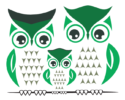CURRICULUM
The goal of every curriculum implemented at MSP is to teach children to recognize God as He is revealed in His creation, through His Word and through His son. Here are the different curriculum areas

The Catechism
The Children's Catechism is derived from The Shorter Catechism of the Westminster Standards. It is a systematic question and answer tool set to music, which aids in memorization. Children learn the first 35 Q/A, which cover the doctrines of creation, of God, of man, and of sin. Additionally, the children memorize scripture which defends the catechism questions.
Music
In music class, the preschoolers learn about pitch, dynamics, scale, tempo, rhythm and more.They are taught the basics of music theory throughout the year beginning with how sound is made up of vibrations and culminating with the orchestra instruments.
Art
The basics of painting and drawing are taught weekly: color, shape, form, value, as well as the five elements of drawing. Preschoolers are also exposed to art history and a major artist whose work exemplifies the subject area they are studying.
Math
Students learn counting, shapes, sorting, and grouping during centers, primarily, but also through music, art, circle time and discovery time.
Language Arts
MSP is a language-rich environment with a carefully selected literature list. Hundreds of books are read throughout the year. The children will begin to learn narration, left to right orientation, sounds of letters, the beginning, middle and end of a story. Daily circle times is an important venue for the teacher to expose and teach language as they progress through learning the alphabet and recognizing letter sounds. Centers activities are designed and implemented to help the students learn their letters, hand-writing, sequencing, left to right orientation and more.
Humanities/Discovery Time
God's creation is the theme for our humanities curriculum, which we call discovery time. the aim is to learn not only about the creation, but the Creator Himself. We have 3 different curriculums for the 3 age groups. Threes study aspects of creation: Water and what fills it, Land and what fills it, and the Sky and what fills it. Fours study the chronology of creation, starting with Day one to Day seven. Fives study creation in the context of the larger story: Creation, Fall, Redemption and Consummation.
Spanish
MSP employs a bilingual teacher to introduce the children to the Spanish language. They are exposed to Spanish language and culture by learning common words and phrases, such as greetings, salutations, colors, and numbers. A consistent and repetitive curriculum encourages the children to find comfort and familiarity in a new language, they are engaged with songs and games and encouraged to participate in a fun, relaxing environment where they can learn about a culture different from their own.

